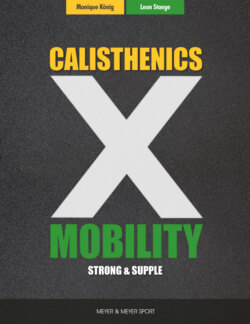Читать книгу Calisthenics X Mobility - Monique König - Страница 15
На сайте Литреса книга снята с продажи.
2 Understanding Mobility 2.1 HOW TO BECOME MORE MOBILE
ОглавлениеFor many, flexibility is a blind spot. Yet there are thousands of books about strength training.
Nearly everyone involved in fitness has held a dumbbell at some point.
But when it comes to mobility, most people think only of stretching. Actually, the ability to achieve a certain amount of mobility isn’t just another type of training but also a very good indicator of the body’s overall exercise capacity.
To better understand this, let’s take a look at which factors affect mobility and why some athletes are very stiff despite doing strength training.
Mobility is grounded in the brain.:
Everything we do in our daily lives or in sports is subject to the brain’s processing of information.
Despite our modern society, our “software” still operates based on the very important survival mechanism, the question our brains pose for everything:
Am I safe, or am I in danger?
This also means our brains must be able to correctly assess movements and situations. What do I mean by input? Input is all the information that’s routed to the brain:
1. Eyes (different ways of seeing and eye movements)
2. (Inner) Ears (hearing and balance)
3. Mouth and throat (taste, tongue position, and jaw movement)
4. Nose (smell)
5. Joints
6. Muscles
7. Skin
This information is handled within fractions of seconds.
1. It’s processed via the different areas of the brain.
2. It’s interpreted: What’s the quality of the information. What does the information mean?
3. It’s analyzed: Am I able to accurately assess the next action or situation? Am I safe or in danger?
When your brain experiences ambiguities during this process and the final analysis determines that your brain is unable to ensure full functionality, your brain protects you by taking the following measures:
As you can see, when you improve the input, the ROM also improves.
With respect to mobility, here’s an example:
When you practice moving your shoulders through their full range of motion (FROM) without crossing the pain threshold, such as doing a swimmer (see chapter 7, “Mobility Exercises”), your brain registers that you have control over every portion of the movement. The more you practice the activation of your shoulder joints and the joints involved in the movement (thoracic spine and shoulder blades), the clearer the image of the movement you’re practicing becomes to the brain.
This takes us to the concept of a body map. Body mapping describes how well your joints and the surrounding muscles’ ability to contract (tighten) are anchored in the brain, because moving a joint also includes the ability to adequately contract muscles and relax them again at the right moment.
Here’s a word picture to help you better visualize this:
Imagine the path to the bakery nearest you. It doesn’t matter if you’re in Tokyo, New York, or your hometown. You know exactly which streets you need to travel to get to that bakery. In your head, you have a “map” to the bakery. But if you were a tourist in New York and someone asked you where to find a bakery, you’d have to resort to Google maps, an external map to show you the right way because your personal map (in your head) doesn’t have a plan.
That’s how it is with movement–or, to be more specific, with your joints’ range of motion. If you always train and move your joints–or, rather, your body–in only one way, these paths will be better anchored in the brain than movements you rarely or never perform. For instance, for a strength athlete, this would mean training with in different ranges of motion.
Disrupting homeostasis is a trigger for lots of pains and limitations. This means possible imbalances in strength and flexibility and can even cause an issue with balance. When you learn to activate your joints and muscles, meaning having sensory and motor control, you’ll become more flexible.
Of course, it doesn’t sound particularly motivating when I tell you that you should practice improving your body’s motor control. That’s why my goal with this book is for you to learn to enjoy mobility training and then practice moving in different ways.
